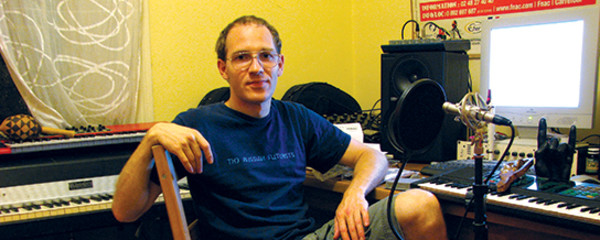Caribou In the Studio
Despite having produced some of indie electronic-rock’s grandest opuses, Dan “Caribou” Snaith has never worked […]
Caribou In the Studio
Despite having produced some of indie electronic-rock’s grandest opuses, Dan “Caribou” Snaith has never worked […]

Despite having produced some of indie electronic-rock’s grandest opuses, Dan “Caribou” Snaith has never worked in a professional studio. He makes all of his music alone in his tiny, apartment bedroom with little more than a computer, a cheap sampler, and a handful of instruments. But as evidenced by the songs “After Hours” and “Desiree” on his new LP, Andorra (Merge), it often seems like he has a 50-member orchestra under his spell. Since 2001’s Start Breaking My Heart (recorded as Manitoba), Snaith has crafted a vibrant, Technicolored sound that embodies the raw wilderness of his upbringing in rural Ontario, Canada. XLR8R rang up Dr. Snaith (he holds a Ph.D. in mathematics and is barely 28) at his current home in London to talk about tiny spaces and huge sounds.
XLR8R: You used to loop samples to compose songs in the past. Did you use that same technique on Andorra?
Dan Snaith: This is the first record where I didn’t record like that. It’s the first time that I’ve actually written things before I recorded them. In the past, it was always just building upon loops and writing things as I go, and just making stuff up to put over top. But this time, it was much more about writing things and [having] the whole arrangement in my head before I started recording.
Many of the vocals on Andorra resemble those found on ’60s pop albums. How did you record them?
I actually recorded every instrument that needed a microphone with this Russian microphone, an Oktava MK-012, which is just like a condenser microphone. It’s really bright-sounding. I recorded all of the vocals with that and I then used a TL Audio channel strip as a pre-amp. As far as getting the vocal sounds that I wanted, it’s a lot of layering. I’d record a part [numerous] times and layer them on top of one another. I tend to either like the dry sound that’s panned hard left and right, or use a kind of reverb on some of the vocals.
How were the drums recorded? The beats blend well in the mixes.
On “Melody Day,” I recorded the drums in our rehearsal studio, but then they actually knocked down that studio a few weeks after I did that. For all of the other tracks, it was usually just a floor tom, a snare, and a hi-hat or cymbal in my room, with the same overhead and a [Shure] SM58 [mic] under the floor tom. It was like a really, really stripped down kit… It’s me playing this weird, Frankenstein kind of kit with two shitty mics on it. I’d then play it twice and layer it on top of one another.
What software do you typically use?
I use Acid, which is the most basic audio-sequencing software on the market. I use a really old, expired version. It [enables me to] do some really simple things, like putting layers on top of one another, allowing me to loop bits or put in a few effects, but not anything like fancy reverbs or compressors. Any of these music programs that are out there do all the things that I want, so it’s not really a question of that being a big part of my sound or anything.
What’s your secret weapon in your studio?
The Boss Dr. Sample SP-303. As well as it being a sampler, it also has a line-in, a pre-amp, and a whole ton of effects on it. I don’t use any amps for guitar or bass or keyboards or any of that stuff; I just plug them straight into this thing and then I can put effects on it really easily. I tend to record effects and all of that kind of stuff on this thing rather than doing it later on. I put vocals, guitar–anything–through there… it’s a versatile little thing. The only thing that I’m really looking for is for everything to be really easy and intuitive to use so that I don’t spend all of my time fiddling with gear.
Given your education background, I’m curious if you use mathematical theories in your music.
Not at all. People think of mathematicians as being really methodical and being really careful, planned-out kind of people, but a lot of them that I met are the most scatterbrained, absentminded-professor type of people. That’s definitely the way I record. There’s crap piled up everywhere, a microphone falls over in the middle of a take, and everything is a bit of a mess; everything is plugged into the wrong thing, the levels are all set wrong, and it’s a constant messing around. As far as using formulas, it couldn’t be further from the way I record.

